#chenopods
Explore tagged Tumblr posts
Text
#2717 - Atriplex buchananii

The binomial is derived from an ancient Latin name which may have come from the Greek a-traphein - ‘without nourishment’ because many of species grow in arid deserts. John Buchanan (1819-1898) was a New Zealand botanist and scientific artist.
A short-lived chenopod found in open, salt-enriched, poorly draining clay or gravel strewn ground. It's most common in open turfs or gravel field near the high tide mark, on offshore islands in guano enriched soils or guano splattered rock. In Central Otago it grows in salt pans and slicks.
The main food plant for two endangered moths from inland Otago - Paranotoreas fulva and an undescribed Loxosteges.
Chapman Road Scientific Reserve, Aotearoa New Zealand.
2 notes
·
View notes
Text
Tarte flambée au chénopode blanc
Cette recette de Tarte flambée au chénopode blanc est un essais très concluant. Dans cette article vous aurez tous les détails pour essayer chez vous. Bienvenue à nouveau sur Le blog des plantes sauvages ☘️ ! Comme ce n’est pas la 1ère fois que vous venez ici, vous voudrez sans doute recevoir mon livre “3 Plantes 3 Recettes 0 stress ” : cliquez ici pour recevoir le livre…

View On WordPress
0 notes
Text
Off Menu Tag
So the brilliant @the-eclectic-wonderer tagged me in this game and I'm just going to apologize to @valentinaonthemoon right now because I'm going to 100% misinterpret the point of this game.
The thing is, I got this this morning and I was thinking about my favorite foods and they just don't go together at all! Like my favorite dish is probably a Thai yellow curry but my favorite drink is definitely a root beer float and so on. But together, like yuck! So I was really really stuck.
But then I remembered this is a genie and they have magic and I actually do have a list of foods I desperately want to eat and will never ever get the change to have. So without further ado...
You're in your dream restaurant and a genie waiter is ready to take your meal order:
Where does my dream meal take place: late Cretaceous North America, about 66 mya on the day the asteroid kills the dinosaurs. Because I'd get to see dinosaurs and then I'd get to see a brilliant falling star and then an explosion and then the sky would look like it had caught on fire due to all the debris shot up into the atmosphere and burning up.
Still or sparkling water: still. I don't really get the whole sparkling water thing tbh.
Poppadoms or Bread: if these are my only choices probably bread especially if I can have it with jam. But if I can choose anything of this type, chips and salsa and guac because I just got back home from France and I have been craving it so much.
Dream Starter: This is where I'm going to go off the deep end and say a like Spanish tortilla style omelet made out of elephant bird eggs because I really want to know what those taste like. They're so big!!!
Dream Main Course: easy. Velociraptor meat. I want to settle one of the most pressing paleontology questions of all time: did dinosaurs taste like chicken?
Dream Side Dish: Follow me on a detour out of bird/dinosaur land and into the world of archaeology. I desperately want to try some plant dishes from the Eastern Agricultural Complex. There's archaeological evidence that the people in the American Midwest had domesticated plants like sunflower, marsh elder, squash and goosefoot (a chenopod like quinoa) before the arrival of maize from Central America. The domesticated versions of these plants are completely lost and I'm desperate to try a dish made out of them.
Dream Drink: I have no idea. Mammoth milk?
Dream Dessert: Now, because I'm pretty sure none of the stuff on my list actually tastes very good I'm going to go ahead and choose something actually tasty to help get the taste of dead dinosaur out of my mouth. My favorite dessert is lemonade cake. It's a confetti cake that has been soaked in condensed lemonade. It's sickeningly sweet, super sour, and topped with an incredibly large amount of whipped cream :)
Tagging, absolutely no pressure: I'm thinking @herbirdglitter cause you always like the archaeology stuff and @val-bespoke because you know I love talking to you about foods which foods we can't possibly believe the other person hasn't tried
#tag game#im so sorry what did I do here#but its true#there are so many foods that don't exist that I want to try#and if there were a magic genie I would 100% be asking for the wackiest food I could never get my hands on in real life
4 notes
·
View notes
Text
i think we Should redomesticate eastern complex crops. bring back chenopod.
1 note
·
View note
Text

Last one for today, a new preview of another part of Kibitzer's home land, where Chenopod runs a little shop of sorts. :3
#game dev#game development#gamemaker#indie developer#indie dev#indie game#pixel art#pixel game#pixel rpg#rpg#scenery#grass#trees#npc shop
17 notes
·
View notes
Text
April 28-30 We were 100s of km from ‘civilisation’ - callooh callay!
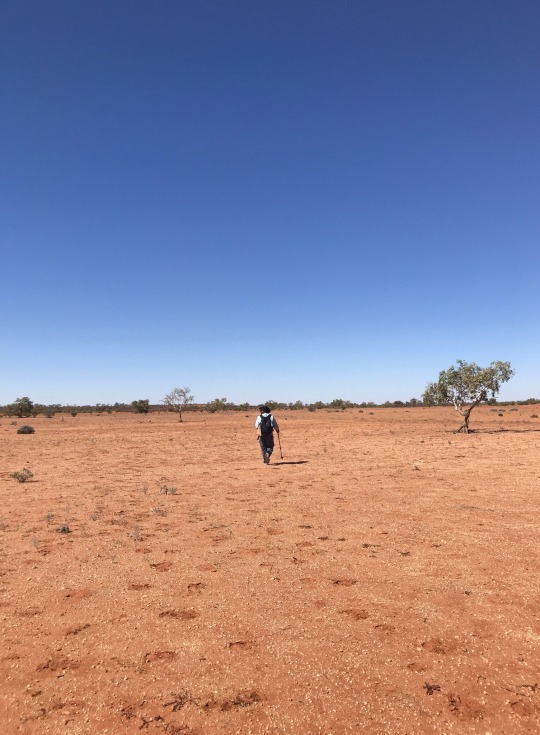
And off we walked out towards the empty horizon under a gigantic dome of cerulean blue. It was like walking through one of those iconic desert paintings - the colours changed from palest gold to deep blood-red. Grey-green and here and there vivid splashes of flowers, the tough little flora punctuated the vastness - with tenacious attitude! The gibber plains over which we also walked, added purple and darkest brown, appearing like dull dark mirrors.

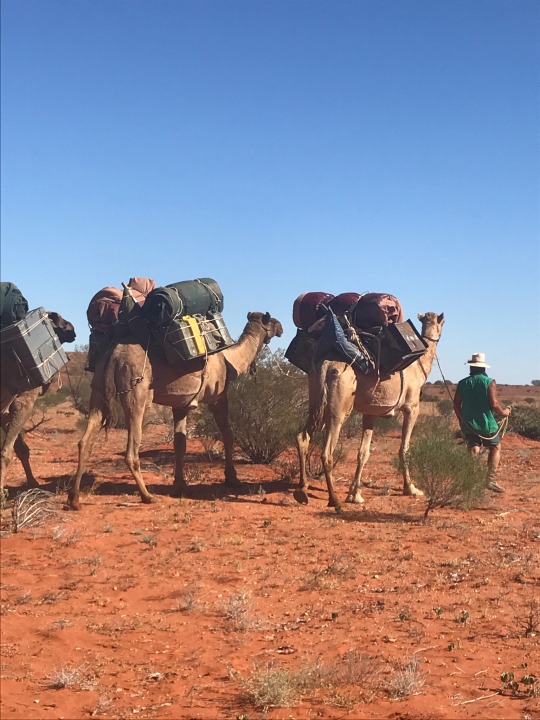
A site which will haunt my dreams for a long time: Harps leading Eddy and, behind him, A String stretched out in a gentle swaying line. Breathtaking!

Don’t get me wrong, it’s harsh out there this poor thing didn’t make it.
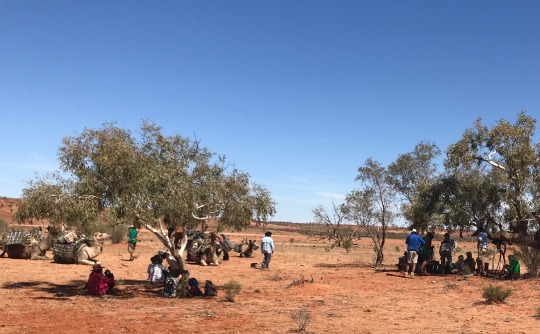
Lunch breaks were taken where shade was to be found and we all crowded into those precious oases, wonderful respites from the relentless sun. The camels just hunkered down to wait. We weren’t allowed to interact with them then because they were ‘on duty’/working. One lunch stop was under a Dead Finish tree. I had read about these trees; they get their name from their ability to survive very harsh climate conditions - if they die that’s the finish for everything.

The desert floor where we were walking was littered with aboriginal artefacts. Charlie showed us many from tiny cutting heads to large grinding stones. Sometimes it was too hot to stop and ponder too long but it was fascinating.

We made a few sightings of dragons or the like and found quite a few burrows some of which we think may have been made by bilbies.

There was great excitement at finding an ancient tree species, Acacia pickardii, a relict population of only 3 tiny populations in Australia dating back at least 5 million years. These trees can live for 500 years.
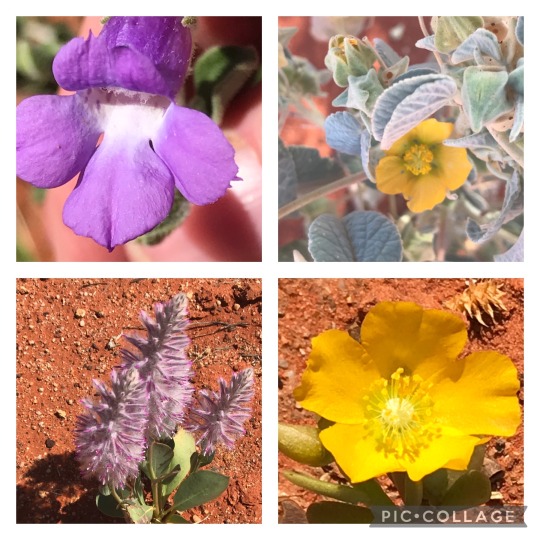
You might not be surprised to know that I was particularly interested in discovering what plants grew out there; I identified at least 30 different species and saw many more. These are a few of the specimens I found. Eremophila obovata (Top L), Chinese desert lantern (Top R), Tall Mulla Mulla (Lower L), Portulaca - buttercup pigface - camels favourites food Lower R).
I also saw a number of different Mulla mullas, potato bush and other Solanaceae, a number from the pea family including Yellow Rattlepod, Goodenias, parakeelya, Button grass (fav food of bilbies), Desert fuchsia and other eremophila, many species of salt bush and chenopods and ....... I could have spent a lot more time just browsing but a string of camels waits for no man - or woman!
“If we could see the miracle of a single flower clearly, our whole world would change." Buddha - supposedly from one of his silent sermons.

There was always lots of laughs around the preparation of our night meals; this night it was a delicious vegetable stirfry with ginger and coconut. There was lots of amazing vegetarian food served on this trek. Lunches were build-your-own wraps with masses of fillings to choose from all set up under a tree on a low table unpacked off the lucky camel. Usually a fire was lit and the billy boiled. Couldn’t get better than that. We just fanned out and found a scrap of shade to rest our feet - or go hunting for birds or flowers!!
Each night we watched the sun set, the moon rise and gazed skyward as a brilliant canopy of stars blossomed. It was glorious! None of my night pix turned out unfortunately but the images are in my head including waking early to simply lie there staring at the moon and stars.
1 note
·
View note
Text
What's Beneficial About Spinach
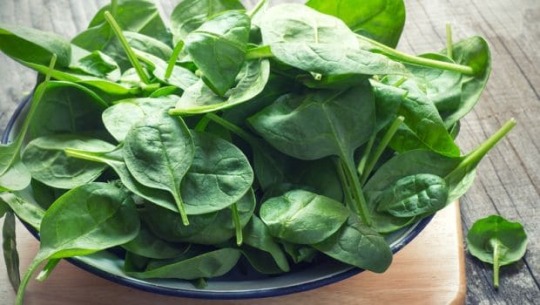
Raw 100g includes daily nutrition of: Manganese (84 percent), Folate (65.7 percent), Magnesium (35.1 percent)Iron (35.7 percent), Copper (34.4 percent), Vitamin B2 (32.3 percent), Vitamin B6 (25.8 percent), Vitamin E (24.9 percent), Calcium (24.4 percent), Potassium (23.9 percent), Vitamin C (23.5 percent)
Recent studies continue to underscore the amazing versatility of spinach. Because this leafy vegetable is rich in water-soluble vitamins, fat-soluble vitamins, minerals, and a wide variety of phytonutrients, there are many different ways to incorporate spinach into your meal plan and enjoy a variety of nutritional benefits. For example, we've seen a recent study in which the sautéing of spinach was best able to retain its total carotenoid content (in comparison with steaming or boiling or frying). Alternatively, we've seen an equally recent study showing far less loss of vitamin C from spinach when this vegetable was steamed for 5 minutes (instead of being microwaved or boiled for that same amount of time. Yet numerous studies also point to the nutrient benefits of raw spinach. For example, about 25% of the folate in spinach can be lost from cooking, and spinach can be thought of as a special nutritional contributor in terms of folate since it ranks as our Number 3 source of this nutrient at WHFoods. Therefore, as you can see, there are important nutritional benefits to be had from many different ways of incorporating spinach into your meal plan. In our World's Healthiest Foods Meal Plan, we incorporate spinach in its raw form in our Energizing Blueberry Smoothie, our Satisfying Strawberry Smoothie, and our Rousing Raspberry Smoothie.
New research is underway involving the nitrate content of spinach. You've probably heard about nitrate (and nitrite) in the context of food additives since both of these nitrogen-containing substances have often been used as preservatives for bacon and deli meats. However, when nitrate is used as a food additive, it is usually in a concentrated (10 or more milligrams per 8 ounces) when compared with its naturally occurring amount in certain foods. For example, even though spinach is a rich source of nitrate, its nitrate content usually totals far less than 1 milligram per 8 ounces. And at this lower, naturally occurring level, the nitrate in spinach may actually provide us with health benefits. For example, bacteria in our saliva and in our lower intestine can convert nitrate (NO3) into nitrite (NO2) and nitrite into nitric oxide (NO); this nitric oxide might, in turn, help to protect proper function of the intestinal lining. While we do not have definitive studies about this potential role of nitrate in spinach, this area of research is one of active interest.
Chlorophyll is the pigment that gives spinach its renowned green color. Inside the cells of the spinach plant, the places where chlorophyll gets stored are called chloroplasts, and their membranes play an active role in converting sunlight into energy (through a process called photosynthesis). These chloroplast-associated membranes are called thylakoid membranes, or simply thylakoids. Because fresh spinach is such a rich source of chlorophyll (and actually our Number 1 source of chlorophyll at WHFoods, containing about 24 milligrams of chlorophyll per cup), it has often been used in research studies as a source for thylakoids and their potential health benefits. Several recent studies in this area have shown thylakoid-rich extracts from spinach to delay stomach emptying, decrease levels of hunger-related hormones like ghrelin, and increase levels of satiety-related hormones like glucagon-like peptide 1 (GLP-1). Exactly what these changes mean is not yet clear, but researchers hope to eventually determine whether routine intake of spinach can help lower risk of obesity partly because of these thylakoid-related processes. It is also worth noting in this context that several prescription drugs currently used to help treat type 2 diabetes (for example, albiglutide, exanatide, dulaglutide, and liraglutide) work by imitating the activity of GLP-1. For this reason, future studies may find a relationship not only between risk of obesity and spinach intake but risk of type 2 diabetes as well.
It is important to underscore the amazing versatility of spinach! Consider these results from our WHFoods rating system: spinach ranks as our Number 1 source of magnesium and iron (both minerals); our Number 2 source of vitamins B2 and B6 (both water-soluble vitamins); our Number 3 source of folate (another water-soluble vitamin); and our Number 2 source of vitamin K (a fat-soluble vitamin). Spinach is also our Number 2 source of vitamin E; our Number 3 source of calcium, potassium, and vitamin A; our Number 5 source of manganese; and our Number 8 source of copper.

WHFoods Recommendations
Our outstanding level of green vegetable intake at WHFoods is 8 servings of green vegetables per day. A variety of days in our World's Healthiest Foods Meal Plan provide this outstanding amount, without compromising the perfect blending of textures and flavors in our World' Healthiest Foods Meal Plan Recipes. The many different types of green vegetables available to provide you with exceptional nourishment are nothing short of astonishing! Not only can you choose from dark green leafy vegetables from the cruciferous group (for example, mustard greens, turnip greens, kale, or collards), but also from the leguminous vegetable group (like green beans or green peas); the squash/gourd group (including zucchini and cucumber); the parsley/umbelliferous group (like fennel and celery); green allium vegetables like leeks, green lettuces like romaine; and finally, of course, the chenopod/amaranth group that includes spinach as well as beet greens. Rather than relying exclusively on any one of these green vegetable subgroups, we recommend that you consider including green vegetables across all of these subgroups when putting together your weekly meal plan.
. A link that takes you to the In-Depth Nutritional Profile for Spinach, featuring information over 80 nutrients, can be found under the Food Rating System Chart.
Health Benefits
Description
History
How to Select and Store
Tips for Preparing and Cooking
How to Enjoy
Individual Concerns
Nutritional Profile
References
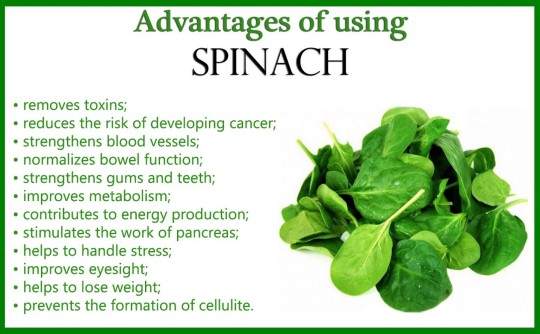
14 notes
·
View notes
Link
Archaeologists have struggled to explain the rapid rise and fall of Cahokia—the mysterious Mississippian mound-building culture that sprang up about a thousand years ago in the fertile southern Illinois bottom lands just across the river from modern-day St. Louis.
Scholars have painted the civilization as a hierarchical, highly centralized society where ruling elites demanded tribute from lowly peasant farmers who toiled in a culture spiritually obsessed with and highly dependent upon the cultivation of corn.
While there's little doubt that farming was the civilization's lifeblood, a new book by a paleoethnobiologist at Washington University in St. Louis offers a compelling case for a much different understanding of the Cahokian culture.
The book also offers a road map for the rediscovery and possible recultivation of an array of highly nutritious wild food sources, including a North American cousin of quinoa, that were once a staple part of the early American diet.
"The real story of Cahokia is about much more than maize and decisions made by a small group of elites," said Gayle Fritz, professor emerita of anthropology in Arts & Sciences and author of "Feeding Cahokia: Early Agriculture in the North American Homeland" (2019 University of Alabama Press).
"It's clear that the vast majority of Cahokia's farmers were women and it's likely that their critical knowledge of domesticated crops and wild food plants would have earned them positions of power and respect at every level of the society," she said.
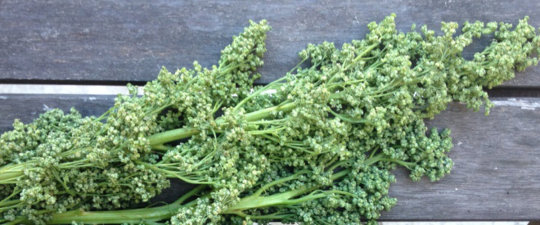
Chenopod, which produces tiny seeds similar to quinoa, has been cultivated and consumed by Native Americans for thousands of years. Also known as lambsquarter or Goosefoot, its young leaves and buds can be prepared like spinach or broccoli when fresh. Credit: Gayle Fritz
Cahokia's rise and fall
Classified as a UNESCO World Heritage site, the Cahokia Mounds complex was the site of North America's largest and most populous city prior to European exploration.
Reaching its apex in the early years of the first millennium (1050 to 1200 A.D.), the city and immediately surrounding region boasted a population in the tens of thousands and exerted influence over other native settlements scattered across a wide swath of the American Midwest.
Then, for yet unexplained reasons, the civilization began to fade. By 1300 A.D., populations living in and near the Cahokia city center were plummeting. By the early 1500s, when European explorers first visited southeastern North America, the great city of Cahokia lay abandoned.
Some scholars suggest the demise was due to periods of heavy flooding or severe drought, or even a massive earthquake, and the impact these calamities may have had on an agricultural system that had grown increasingly dependent on maize.
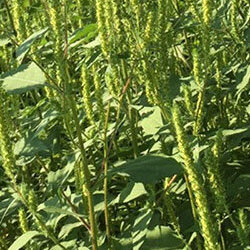
Domesticated long ago by Native Americans, Marshelder, also known as sumpweed, can still be found growing wild in marshy bottomlands near Cahokia. Ill. Credit: Gayle Fritz
Fritz is not convinced
She questions the evidence for these disasters at Cahokia, as well as the notion that such severe weather events could have crippled the city's ability to feed itself. Her research shows that the city's food production network was extremely well diversified, stable, sophisticated and situated in some of the world's most fertile farmland. While natural disasters may have sparked de-stabilizing social or religious unrest, the women who controlled the society's farming complex were more than capable of weathering severe climatic disturbances, she argues.
Fritz documents early uses of what may have been America's first domesticated crop, a strain of bottle gourd that first floated to these shores—genetic evidence suggests—from Africa. She explores the origins of other early food crops, such as a native squash, sunflower, erect knotweed and chenopod, which were domesticated in the midcontinent and grown by generations of farmers before, during and after Cahokia's heyday.
Cultivating nature's bounty
Fritz details how these and other ancient food sources were gradually incorporated into field cultivation systems, with some eventually showing signs of genetic changes related to domestication. She backs up her assertions with clear overviews of the best available archaeological evidence, including her own early work on ancient stashes of native seeds in protected bluff shelters of the Ozark Plateau.
She also explains how early Americans learned to maximize harvests of wild nut crops, such as hickory and acorns, by giving the best mast-producing trees a competitive edge—girdling inferior trees and routinely burning off underbrush to gradually create stands that European explorers later described as "nut orchards."
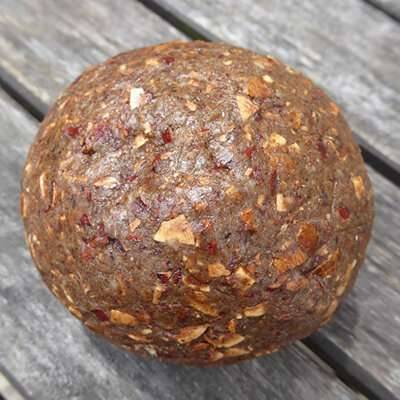
Ku-nu-che ball, three inches in diameter, made from cracked, sifted and pounded hickory nuts, for Cherokee hickory nut soup. Credit: Gayle Fritz
As her book makes clear, the evolving consensus on Cahokia's food culture is a function of rapidly improving scientific techniques and field work practices that are unlocking evidence often overlooked in earlier archaeological investigations.
Science still unlocking Cahokia's secrets
Recent studies have employed isotopic analysis of human bones from Cahokia to show that a surprisingly large percentage (perhaps 20-30 percent) of the residents arrived there from other locations in eastern North America.
A key breakthrough, she argues, is the now routine use of water flotation techniques to separate seeds and other organic particles from excavation dirt, allowing these fragments to be identified and further analyzed in the laboratory.
Early proponents of flotation studies, such as Patty Jo Watson of Washington University, used the technique to study samples collected along the Green River in Kentucky near the Salts and Mammoth caves. Their research showed that American hunter gatherers began adding cultivated crops to their diets as early as 2,500 B.C., resulting in heavy reliance on plants such as sunflower, marshelder, chenopod, erect knotweed and maygrass.
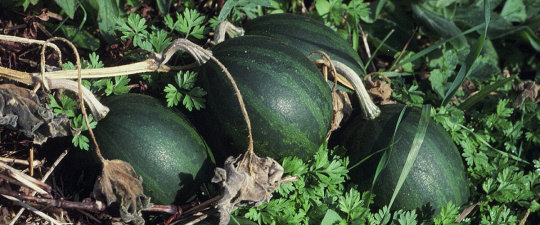
Cucurbita pepo gourds, such as these growing wild in the Illinois River Valley near Grafton, Ill., were one of the first plants to be domesticated by early Native Americans. Credit: Gayle Fritz
Seeing the cornucopia beyond the corn
In the past, researchers may have underestimated the importance of small grains in the diets of ancient civilizations because researchers sifted excavation dirt through larger screening devices designed to uncover pottery sherds, tool pieces and other larger-scale artifacts.
Traces of corn, with its large kernels and cobs, were easier to document than tiny wild grains the size of quinoa.
Dozens of large archaeological projects at Cahokia and surrounding sites have generated flotation-derived data showing that the native seed crops were produced in copious quantities during the centuries before and after Cahokia's rapid rise.
"The most unexpected finding was that pre-maize crops did not decline after corn was embraced at A.D. 900. Instead, all available crops��old and new—increased in abundance, giving urban Cahokia a biologically diverse food base, quite different from the corn-dominated cuisine sometimes described," Fritz said.

The Keller figurine, one of several flint-clay statues from the Mississippian mound-building culture unearthed near Cahokia Mounds, was once seen by some scholars as a “corn goddess” sitting on a row of corn cobs. Credit: Tim Vickers via Wikipedia Commons
Cahokia's women found power in the fields
But larger artifacts also figure into Fritz' theories about the role of women in Cahokian society. She builds her case for a farming system dominated by women and their daughters in part on a reassessment of small, flint-clay ceramic statues of women that have been unearthed at Cahokia and other Mississippian sites.
The figurines, which other researchers have described as corn goddesses, often depict an older woman kneeling with outstretched arms. The statues are embellished with intricately carved snakes, plant stalks and vines, and flower heads that some scholars have been quick to characterize as symbols of corn and fertility. Moreover, the statues have been interpreted as serving the goals of an elite-controlled priestly cult.
Fritz argues that many of the carvings more accurately represent sunflower seed heads and squashes, and that the tendency for other scholars to see corn is a function of zeacentric bias—an exaggerated fixation on the culture's perceived ideological elevation of maize.
Her explanation draws heavily on the work of Carol Diaz-Granados, a research associate at Washington University, and other scholars who have studied the imagery behind Native American art and rock drawings. This context suggests the Cahokia figurines represent a character known as "the old woman who never dies" or "grandmother" who is central to the beliefs of modern Siouan speaking tribes, such as the Mandan and the Hidatsa.
Women in these tribes who belonged to organizations called "Goose Societies" played a dominant roles in tribal farming and spiritual life, with younger women moving up through the ranks by virtue of their industriousness and the skills manifested by themselves and their kin groups in the farm fields.
"Long before corns, beans and squash became such a staple part of Native American diets across the midcontinent, it's likely that the women farmers of Cahokia were appealing to a similar Earth Mother to guide their cultivation and harvest of native grains, such as maygrass, sunflower and chenopods," Fritz said. "This alternative scenario situates the women—the farmers themselves—as key players rather than placing them under the control of an elite-centered priesthood."
#archaeology#native american#first nations#indigenous#women#woman#history#food#corn#squash#cooking#cahokia#illinois#mississippians
130 notes
·
View notes
Link
[Had this in my drafts, today noticed the article going around, decided to post from my drafts instead of reblogging for various reasons]
Articles like this one point to how easily the default patriarchal view erases vast chunks of history and science-- an assumption that a society has to be run by males vanishes the importance of not just half a population, but erases the truth of the food sources of an entire civilization, erases indigenous knowledge, narrows ideas of human potential overall, erases potential for the future, and at some point just looks like making up a bunch of shit based on erroneous assumptions and, usually, misogyny and racism.
Excerpt:
But larger artifacts also figure into Fritz' theories about the role of women in Cahokian society. She builds her case for a farming system dominated by women and their daughters in part on a reassessment of small, flint-clay ceramic statues of women that have been unearthed at Cahokia and other Mississippian sites.
The figurines, which other researchers have described as corn goddesses, often depict an older woman kneeling with outstretched arms. The statues are embellished with intricately carved snakes, plant stalks and vines, and flower heads that some scholars have been quick to characterize as symbols of corn and fertility. Moreover, the statues have been interpreted as serving the goals of an elite-controlled priestly cult.
Fritz argues that many of the carvings more accurately represent sunflower seed heads and squashes, and that the tendency for other scholars to see corn is a function of zeacentric bias—an exaggerated fixation on the culture's perceived ideological elevation of maize.
Her explanation draws heavily on the work of Carol Diaz-Granados, a research associate at Washington University, and other scholars who have studied the imagery behind Native American art and rock drawings. This context suggests the Cahokia figurines represent a character known as "the old woman who never dies" or "grandmother" who is central to the beliefs of modern Siouan speaking tribes, such as the Mandan and the Hidatsa.
Women in these tribes who belonged to organizations called "Goose Societies" played a dominant roles in tribal farming and spiritual life, with younger women moving up through the ranks by virtue of their industriousness and the skills manifested by themselves and their kin groups in the farm fields.
"Long before corns, beans and squash became such a staple part of Native American diets across the midcontinent, it's likely that the women farmers of Cahokia were appealing to a similar Earth Mother to guide their cultivation and harvest of native grains, such as maygrass, sunflower and chenopods," Fritz said. "This alternative scenario situates the women—the farmers themselves—as key players rather than placing them under the control of an elite-centered priesthood."
So much of human history has been written down by males with a vested interest in a narrative that doesn’t even factually exist, and here’s yet another example. I love these researchers and discoverers of truth.
4 notes
·
View notes
Text

Beets, The Unbeetables🤓👊
•
•
🌱Beets are a member of the chenopod family. Its relatives are (Swiss) chard, spinach, and quinoa
•
•
🌱Beets and it's greens are packed with nutrients like iron, manganese, copper, potassium, folate, vitamin A and K, and magnesium
•
•
🌱The presence of calcium, betaine, B vitamins, iron, and antioxidants keeps beets amongst the best liver foods. Beets also thin the bile, allowing it to easily flow through the liver and small intestine – this further enhances liver health.
•
•
🌱The betalin compound found in beets, which gives them their red color, helps to capture troublesome toxins and flush them out of the system via the urinary tract.. The fiber in beets clears the toxins that have been removed from the liver – making sure they don’t re-enter the body. Making it a great hangover cure!
•
•
🌱Ancient Greeks used beets to treat a wide range of ailments, such as headaches, constipation, toothaches, wounds, and skin problems. In fact, beets were so highly regarded that they were often used as an offering to the god Apollo- Cool right!
•
•
REMEMBER☝️- The entire beet is edible, from the top of the greens to the bottom of the root.
•
•
•
•
#beets#healthandwellbeing#food#facts#vegan#recipe#tips#fitness#personal#juice#beetroot#mealprep#food tips#foodforthought#soulfood
9 notes
·
View notes
Text
J35 et 36 2 jours de Hiking dans le parc naturel Paklenica ! On gravit les 1400m pour rejoindre le refuge Struge ( à prononcer "strouuugeeuh") en passant par la grimpette d'un petit sommet. Il vente fort, c'est parfois éprouvant ! On retrouve nos copains belges Claire et Adrien pour une chouette soirée. On deguste une soupe ortie-chenopode locaux ainsi qu'une tisane à la sauge fraîche 😋
Le lendemain, on a trop de chance le Vaganski, le plus haut sommet du parc, est degagé ! Depuis la-haut se dessine la superbe chaîne montagneuse Velebit, au loin l'horizon tout plat de l'adriatique. La descente est moins fun, mais le plouf dans la mer et des bières avec les copains, c'est bienfaiteur hihi
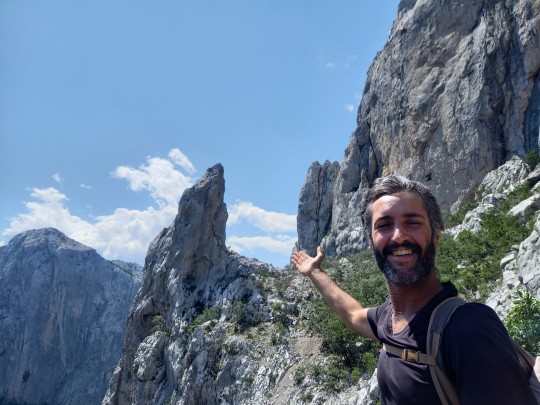
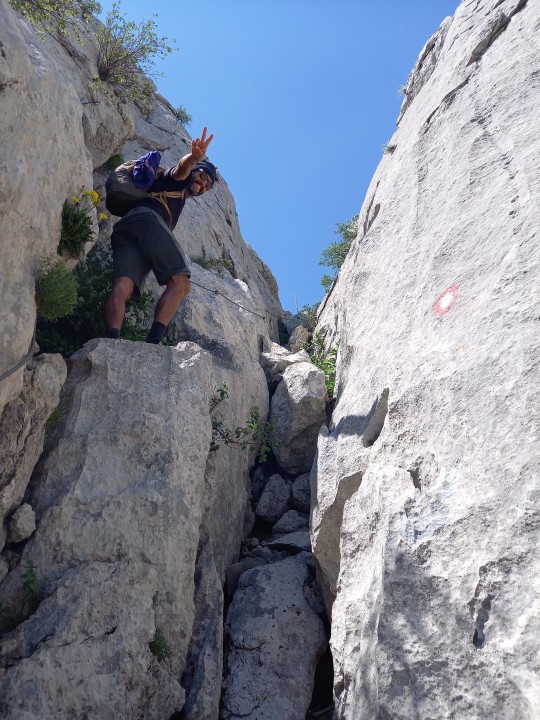


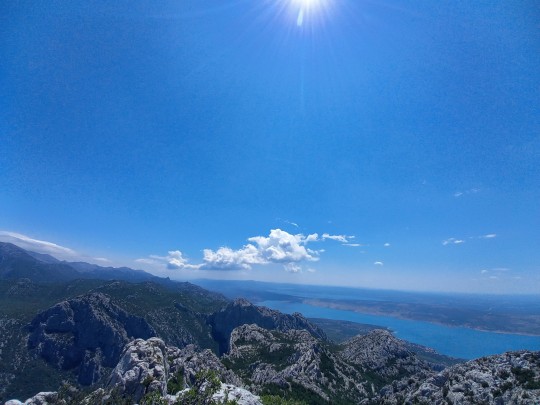
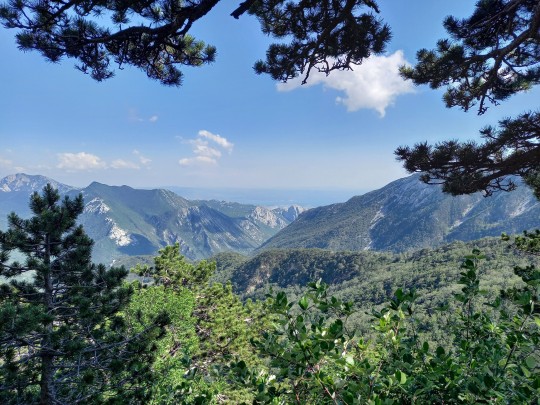
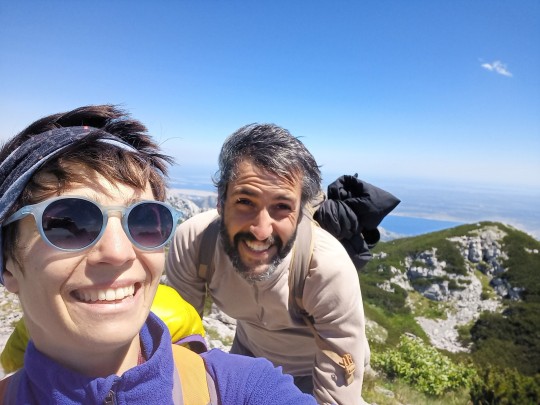


0 notes
Photo

Tattoo by @carloroffare ✨ Petite chenopode pour Natasha, merci d‘avoir choisi ce dessin de mes flash! - - Done in Bruxelles @deuilmerveilleux - - #tattoo#chenopodium#bruxelles#botanicaltattoo https://www.instagram.com/p/Cb-t5CSgA9P/?utm_medium=tumblr
0 notes
Text
[Image: Screencap from Allergy Plus indicating that the allergy forecast is 10.5 (high) with a nearly complete red circle. Predominant allergies are listed as ragweed, nettle, and chenopods. End ID.]
Just downloaded the app and got 10.4 in my area from entirely the same culprits. Suddenly I am no longer wondering why I've been sleeping like crap recently and am having extra difficulty at work.
Also, while I've got the post scheduled to go up in a couple of weeks, here's an early reminder for all of my followers that lots of pollen in the air can have a negative effect on mental health conditions (note: suicide reference at link). If you're in a place where there's lots of pollen right now, or there will be soon, keep this in mind and remember to take care of yourselves!
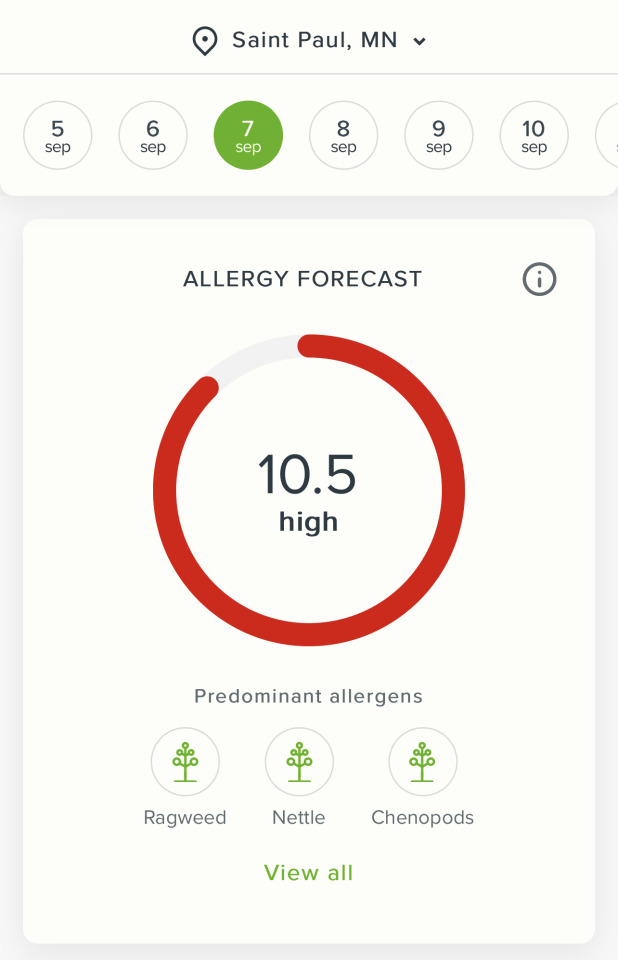
Fucking ragweed.
Edit: app is Allergy Plus.
257 notes
·
View notes
Text
purée de tegragone cornue
purée de tegragone cornue
c est a partir de juillet jusqu’au gelées que vous pourrez profiter de cette plante aux feuilles charnues, de la famille des chenopodes, proche de l’épinard ! tiède ou froide, parfaite pour en accompagnement et présentation des poissons, viandes blanches Ingrédients pour 4 personnes: 5 poignées de feuilles de tetragone200 gr de pomme de terre a chair ferme, cuite en dés a la vapeursel…

View On WordPress
0 notes
Text

A talk sprite of Chenopod, my silly old doctor.
#game dev#game development#gamemaker#indie dev#indie developer#indie game#pixel art#pixel game#pixel rpg#rpg#talk sprite#npc#pixel sprite
8 notes
·
View notes
Quote
I'll let the text speak for itself: "So this is how it works, I said to myself, as if I’d caught an ideological mechanism in flagrante delicto: you let a young man committed to anticapitalist struggle shower in the overpriced apartment that you rent and, while making a meal you prepare to eat in common, your thoughts lead you inexorably to the desire to reproduce your own genetic material within some version of a bourgeois household, that almost caricatural transvaluation of values lubricated by wine and song. Your gesture of briefly placing a tiny part of the domestic–your bathroom–into the commons leads you to redescribe the possibility of collective politics as the private drama of the family. All of this in the time it took to prepare an Andean chenopod. What you need to do is harness the self-love you are hypostasizing as offspring, as the next generation of you, and let it branch out horizontally into the possibility of a transpersonal revolutionary subject in the present and co-construct a world in which moments can be something other than the elements of profit." If this sounds like great writing to you, then I strongly encourage you to read this book. To me, it sounds like a writing undergrad trying to impress his professor as he sits at his laptop surrounded by dictionaries and thesauri. Unreadable, pretentious dreck.
R. A. Raab, perfectly summing up my feelings about Ben Lerner’s “10:04″
1 note
·
View note